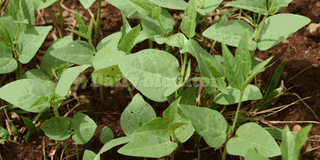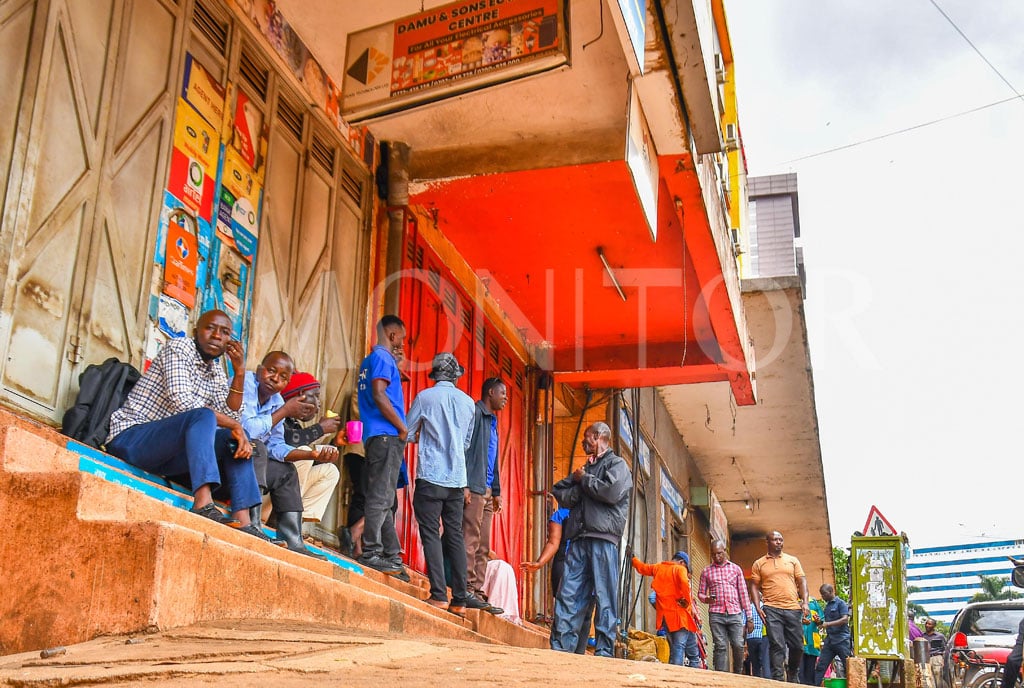Plant cowpeas this rainy season

Cowpea leaves are ready for harvest after three weeks. PHOTO/ISMAIL KEZAALA
What you need to know:
- Some farmers prefer to uproot a whole plant and sell it in the market as it is.
- The end consumer will remove the leaves for cooking. Other farmers prefer harvesting a few leaves from the plant.
- This results in the cowpea plant developing more leaves.
Cowpea (vigna unguiculata) farming is popular in Uganda’s arid and semi-arid areas due to its high nutrition value, short harvest period, and hardiness.
The cowpea is also known as the black-eyed pea. In Uganda, it is popularly known as goobe, eboo or boo.
Farmers prefer harvesting cowpea leaves to the grains.
Dr Emmanuel Mbeyagala, in charge of breeding drought resistant and pest and disease tolerant bean varieties at the National Semi- Arid Resources Research Institute (NaSARRI) in Serere, says farmers should consider farming cowpea as a vegetable because of its short harvest period of three to four weeks and its ability to be grown alongside other crops. The cowpea is rich in Vitamin B complex, calcium, iron, and zinc.
Benefits
The cowpea is packed with nutrients. It is rich in fibre, iron, protein, and potassium. It also has low calories and fat making it a good food when it comes to weight loss and other lifestyle-related conditions.
Cowpeas are rich in vitamin B9 (folic acid) which helps in the development of the foetus during pregnancy. Folic acid deficiency in pregnancy might lead to birth defects.
Cowpeas are rich in iron which helps in the formation of the red blood cells. Iron helps prevent conditions like anaemia. Due to the presence of copper and potassium in cowpeas, consuming cowpeas on a daily basis will improve your metabolic health and digestion.
The presence of calcium, phosphorus, zinc, magnesium, copper, boron, and Vitamin D in cowpeas helps in the formation and maintenance of strong bones.Cowpeas contain good amounts of magnesium which help in the processing of sugars and carbohydrates.
Varieties
Secow-2W which means Serere cow pea is white in colour and is the most prominently grown by farmers in Eastern and Northern parts of Uganda
Secow-2W
Secow-2W is a cowpea variety that is grown for both the greens and the leaves. It is tolerant to yellow mottle virus and scab. Secow-2W can tolerate the damage from aphids and thrips. Secow-2W is also moderately tolerant to powdery mildew and septoria leaf spot.
Secow-2W will develop flowers in 60 days after germination. Machakos 66 grows well at altitudes of 1200 to 1500 metres above sea level.
Secow-1P
Secow-1P is another variety of cowpeas that is grown as a vegetable and grain and flowers 60 days after germination. It can withstand aphids, pod borers, and leafhoppers but is prone to cowpea yellow mosaic virus.
Secow-3B
Secow-3B is a variety of cowpea that can be grown for both grains and leaves. It is tolerant of leafhoppers, pod borers, thrips, and aphids. Secow-3B has demonstrated good resistance to fungal diseases and the cowpea mosaic virus.
Other varieties include Secow-4W and Secow-5T. Secow-4W produces white seeds upon maturity. According to Dr Mbeyagala, this variety is also resistant to fungal diseases and mosaic virus.
Agronomy ---Soil requirements
Cowpeas are well adapted to sandy loam or clay loam soils. The crop will perform well on rich, well drained soils with a pH range of 6.0 to 7.0.
The farmer is expected to plough the land early enough and plant at the onset of the rain season.
How to propagate
The plant is directly seeded using disease free seeds. Farmers are expected to purchase quality seed in agro input dealer shops or directly from seed companies with outlets from the country. They can also keep seed from previously grown cow pea but which is kept free from post-harvest pests.
How to plant
Farmers are advised to clear the site of shrubs and stumps, alternatively they can use chemical inhibiting herbicides such as weed master to spray against the emerging weeds.
Cowpeas can be planted either on ridges or on flat beds depending upon a farmer’s chosen field preparation.
It is advisable to sow three seeds per drilled hole of about 2cm deep, then gently rake the soil to cover the seeds. Maintain a spacing of 60cm between rows and 30 cm within the plants in a row.
Where the cowpea is to be intercropped or relayed with other crops like maize, a spacing of 75cmx50cm should be maintained. The other option is to broadcast the seeds.
After two weeks when the seeds have emerged, thin the seedlings to leave two plants per stand.
In an acre, about five to seven kilogrammes of seed is required and the farmer must ensure there is enough moisture in the soil to avoid drying up.
Fertiliser application
For optimal production, goobe requires phosphorus and some amount of organic matter in the soil.
Apply a fertiliser rich in phosphorus for example TSP on your farm two weeks before planting cowpeas.
The reason for applying phosphorus fertiliser is to enable the roots of the cowpea to develop nodules which will help the plant fixate nitrogen from the air.

Cowpea seeds.
Apply single or triple superphosphate fertiliser at the rate of 17 to 22 kilogrammes per acre.
For organic matter apply well-composted manure at the rate of two tonnes per acre. The manure should be broadcast and mixed well into the soil. This should be done at about two weeks before the planting date.
Weeding your cowpea garden
You should remove weeds from your cowpeas farm twice per growing season. The first weeding is done two weeks after the emergence of weeds and the second weeding done as the weeds emerge.
Watch out for a weed called Striga. It should be removed early enough before it develops and propagates. Adequate manure and fertiliser application helps in reducing the infestation of Striga.
Pests affecting cowpea
Pests can seriously affect your cowpea crop. They reduce the quality and quantity of leaves and grains. For optimal production, you need to have a pest control strategy in order to make your cowpea farming worthwhile.
The major pests that affect cowpeas are aphids, blister beetles, thrips, pod borers, and root-knot nematodes.
Aphids in cowpea
Aphids in cowpeas are tiny insects that suck sap from the leaves and stem of a cowpea plant. They secrete honeydew on the plants. Honeydew from the aphids creates a favourable condition for the growth of sooty mold. Aphids are also carriers of disease-causing viruses such as the Mosaic virus.
While some cowpea varieties can withstand an onslaught from aphids, it is good to control them so that they do not adversely affect your harvest. This is because aphids can lead to the death or stunting of your cowpea plants.
To control aphids use cultural methods such as the ladybird beetle that is a natural predator of aphids. You can also use pesticides, both chemical and organic to control aphids.
Blister beetles
Blister beetles are large beetles that measure between two and five centimetres. They are either black and yellow in colour or black and red in colour.
They feed on the cowpea flowers hence affecting the development of the cowpea pod. The pollen from maize plants can attract blister beetles.
To control blister beetles, pick them by hand, and destroy them. Make sure you wear gloves. As a defence mechanism, blister beetles secretes a liquid that can burn the skin.
Thrips
Thrips are tiny black insects that lay eggs on the flowers of the cowpea plant. They feed on the cowpea flower which eventually drops or grows out of shape. This affects the development of the seed pod leading to decreased production. To control thrips on cowpeas plant maize and sorghum and practice field hygiene. Destruction of host plants also helps in the control of thrips in cowpeas. You can also plant cowpea varieties that are resistant to thrips. Use chemical pesticides to also control thrips.
Pod borers
Pod borers are moths that affect the cowpea plant by feeding on all parts of the plant including the leaves, flowers, stems, and pods. Pod borers will affect your cowpea plants at any stage of development. The adult pod borer will feed on flowers and young cowpea pods as the young pod borer caterpillars feed on the flower and the leaves of the cowpea plant.
Pod borers will cause severe damage to a cowpea farm since by feeding on both the pods and the leaves they will affect the production of cowpea vegetable and cowpea grain.
You can use pesticides, both chemical and organic to control pod borers in cowpeas.
Root-knot nematodes
Root-knot nematodes are tiny insects that feed on the roots of the cowpea plants.
Their feeding activity makes the roots develop swellings known as galls. These swellings interfere with the nutrient intake of the plant through the roots. The galls resulting from root-knot nematodes infestation can be differentiated from the nodules brought by rhizobium bacteria by colour.
The beneficial nodules are usually small, round in shape, and have a pink colour inside. Attack by root-knot nematodes exposes the plant to other diseases such as fusarium wilt. A cowpea plant that has been attacked by root-knot nematodes will look stunted and malnourished. It might eventually fall off.
To control root-knot nematodes in cowpea, practice crop rotation with crops that are resistant to root-knot nematodes. These include cereals and onions. After harvesting, uproot the entire crop and destroy any affected roots by burning.
Cowpea diseases
Fusarium wilt is a fungal disease that affects the tissue of the cowpea plant that is responsible for transporting water and nutrients. Cowpea plants that are affected by fusarium wilt will develop brown stem tissues and wilting. They will have stunted growth. To control fusarium wilt in cowpeas, control root-knot nematodes. The damage caused by root-knot nematodes exposes the cowpea plant to the fusarium wilt fungus.




